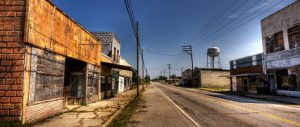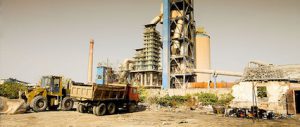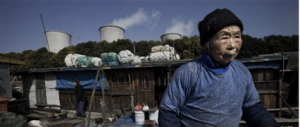Former industrial land is referred to in Europe and the United States as “brownfield”. It is a more refined term for this often polluted land than its routine designation in the Chinese media: “toxic land”. Either way, these sites can present a grave and lasting danger to human health.
In the last few years, these areas have created a new nightmare for China’s cities. Southern Weekend found that many unremediated brownfield sites, left behind by relocated factories, have proved too tempting for local government and property developers, who have used the sites for affordable housing and other projects. But few people in China think about the history of the land their homes are built on.
As night falls in Wuhan, central China, more than half of the apartments in the Yangtze Pearl housing development remain unlit: this social housing community – 60% of the units are affordable homes – is far from being fully occupied.
Han Han, 27, owns a 93 square-metre apartment here, bought in an unfinished condition with his parents’ life savings and a 100,000-yuan (US$15,800) loan. On November 30, just as Han’s family members, no longer forced to rent or live separately, were about to move in together, they saw on the news that the development was built on “toxic land”.
“We were devastated,” said Han. “We spent our life savings on a toxic home.”
The Yangtze Pearl site was polluted over a 60-year period, when it was home to Wuhan Jiu’an Pharmaceuticals and then Wuhan Yangtze Chemicals. After the chemical plant stopped production in 1997, another company used the site to manufacture additives for electroplating processes. In March 2009, an environmental report by the Institute of Environmental Evaluation at the China University of Geosciences in Wuhan found that many of the products manufactured at the site used toxic, even deadly, fluorides and electroplating additives.
This is a classic brownfield site: “toxic land” polluted by industry and in urgent need of remediation.
The four main types of brownfield site pollution are heavy metals, electronic waste, petrochemical pollutants and persistent organic pollutants. Once in the soil, petrochemical and organic pollutants, in particular, can enter the human body through flower beds, pipes and other routes, and land can remain toxic for up to a century. Some pollutants, such as poly-aromatic hydrocarbons, are carcinogens, which can also affect the wider population through the groundwater.
“Organic pollutants are slowly released from the soil. If you take your children out for a walk every day, the impact will increase,” said Gao Shengda, executive editor at HJXF.net, a website focused on environmental remediation in China.
The Yangtze Pearl development had been under construction for over a year and was almost complete when the Wuhan Environmental Protection Bureau found that it failed to meet environmental requirements. The developer levelled the soil, laid down an impermeable lining and covered it with clean soil before planting greenery. In September 2009, the site finally passed an environmental assessment by Wuhan Environmental Monitoring Centre. The apartment owners were not convinced: they blockaded the road and refused to move in, demanding alternative housing, but to no avail.
It is not uncommon for brownfield sites to be used for affordable housing. In Guangzhou, south China, the former sites of the Guangzhou Nitrous Fertilizer Factory and Southern Steel Factory were both used for this purpose, as were the sites of Third Chemical Plant and Red Lion Paint in Beijing. But it’s not just social housing. Gao Shengda said: “In many more cases, affordable housing has been repackaged as normal private housing, as this maximises profits.”
Gao gave the example of Wuhan Sanjiang Space Estate Development, which in March 2006 was awarded the tender to build private apartments on the Heshan 001 plot, a 280 mu site [one mu is about 667 square metres] 20 minutes’ drive from the city center. The following year, a construction worker fell ill on the site and a subsequent investigation determined that this was the former location of the Wuhan Fertiliser Factory.
The developer demanded its money back and Wuhan Land Centre paid 120 million yuan (US$19 million) in compensation for its failure to reveal the history of the site. Remediation, at a cost of 232 million yuan (US$37 million), only started in May 2011.
The histories of brownfield sites are often covered up and authoritative data on the extent of the problem do not exist. Southern Weekend asked a number of academic institutions and companies working on soil remediation for figures, but none were able to provide answers. In 2006, the State Environmental Protection Agency (now the Ministry of Environmental Protection) and the Ministry of Land and Resources launched a three-year survey of soil pollution nationwide. But there is still no sign of public data on brownfield sites.
Figures on factory relocations, however, can provide some clues. China’s more developed cities started large-scale relocations of factories out of urban areas as early as the 1990s.
Luo Yongming is deputy director of the Chinese Academy of Sciences’ Yantai Institute of Coastal Zone Research. His research suggests that large numbers of brownfield sites have been used for property development. Luo also points to incomplete statistics indicating thousands of polluting factories were moved out of places such as Beijing, Jiangsu, Liaoning, Guangdong, Chongqing and Zhejiang, leaving behind over 20,000 hectares of land – the equivalent of 28,000 standard football pitches.
A 2010 World Bank report on brownfield remediation and redevelopment in China said that surveys in Beijing, Shenzhen and Chongqing found pollution to be relatively serious in one fifth of sites left behind by relocated factories. Between 2005 and 2006, the Beijing Environmental Protection Bureau investigated 18 sites where chemical factories had ceased, or were soon to cease, production. Seven of them were deemed polluted, in some cases to a depth of 15 metres, and in need of essential remedial work before they could meet the environmental requirements for their planned use.
To date China has not seen any concrete cases of residents – as opposed to workers – being harmed by brownfield pollution. Gao Shengda said this is because China’s property development sector only took off in 2002 and it was 2005 before people started moving into their new homes. The damage done by pollution can take many years to become apparent, and then monitoring and elimination of other possible causes is necessary to confirm the link.
The first concerns about brownfield pollution were raised in 2004 after three workers were poisoned while digging on the site of a new subway line at Songjiazhuang, in Beijing. The site had originally housed a pharmaceutical factory, and was later taken over by a paint manufacturer. “There was no concept of soil remediation then,” said Gao. “The contaminated soil was just dug out and taken away. But that made everyone aware of the potential risks of industrial sites.”
In Europe and north America, soil remediation work started in the 1980s. But in China it has only started in a small minority of cities, and only over the last five years. Beijing, Shanghai and Chongqing have all published guiding documents on the practice, but even in places where it is happening, there are limitations, for example in the way that cities contract soil remediation work to local firms.
Many more cities, including Wuhan, still lack the appropriate mechanisms. Just like with the Yangtze Pearl development, attention is only paid to the issue when the media exposes a story or poisoning incidents occur.
Southern Weekend failed to find comprehensive figures on soil remediation nationwide, despite asking a number of research institutes and companies. “With some sites, even if remediation work is done, the developer keeps quiet about it for fear of damaging sales,” said one interviewee. But they all agreed that soil remediation work is “very limited”.
China still has no law on soil pollution that would make remediation compulsory. It does not even have standards for the surveying, risk assessment and remediation of polluted sites. Although China passed a law on environmental impact assessments in 2003, this does not capture existing brownfield sites. The law covers the environmental impact a new project will have, but not the history of the site.
To date, there have only been two national-level documents issued on the remediation of polluted sites, both of which put forward only guiding principles for regulation. There are no concrete rules for implementation and punishment, and so there is no real compulsion to follow those principles.
Bao Xiaodong and Zhang Xinyuan are reporters at Southern Weekend, where this article was originally published.
Homepage image by webfee


